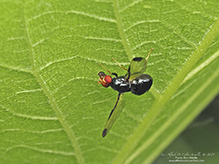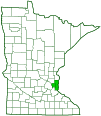picture-winged fly
(Pseudoseioptera albipes)
Conservation • Description • Habitat • Ecology • Distribution • Taxonomy
|
|
||||||||||||||
Description |
Pseudoseioptera albipes is a small picture-winged fly. It occurs in eastern and central North America. The larvae live in rotting vegetables and fruit and in feces. Adults use their distinctively patterned wings in courtship behavior. These traits are common among all picture-winged flies but are not unique to them. Beyond this, little is known of the biology of the species. Adults are about 3 ⁄16″ (5 mm) in length. The head is large. There is a large compound eye on each side of the head and three small simple eyes (ocelli) in a triangle on top of the head. The compound eyes do not meet at the top of the head on either sex. The upper part of the head (frons), corresponding to the forehead, is reddish, and the reddish area continues around the back of the ocellar area, which is black and shiny. The area between the face and the inner margin of the compound eye (orbital area) is broad and is covered with a fine white dust (pollinose). The face is pale yellow. The cheeks (gena) are shiny yellow. The antennae are reddish yellow and have three segments. The third segment is rounded above, and there is a large bristle (arista) on the upper side. The arista is sparsely hairy. The tube-like collection of mouthparts (proboscis) is black or brown. The thorax is shiny and entirely black, with no pale stripes. The legs are mostly black. On the front and muddle legs, the fourth segment (tibia) is brownish. The last part of each leg (tarsus), corresponding to the foot, is yellow. The wings are clear with a slight yellowish tinge. The subcostal cell and the stigma are black, together making a black stripe extending from the base of the wing to the leading edge (costal margin) a little beyond the middle. There is also a dark brown or black spot at the wing tip. The R4+5 cell, in the outer middle of the wing, has a short r-m cross-vein at the base, is nearly parallel sided, and is broadly open at the tip. The open area at the tip is twice as wide as the length of the r-m cross-vein. This feature distinguishes the genus Pseudoseioptera from Seioptera. The veins in the clear area are yellow, while the veins in and surrounding the black areas are black. The balancing organs (halteres) are white. |
Size |
Total length: ⅛″ to 3 ⁄16″ (3 to 5 mm) |
Similar Species |
Habitat |
|
Ecology |
Season |
|
Behavior |
|
Life Cycle |
|
Larva Food |
|
Adult Food |
|
Distribution |
||
|
Sources |
|
| 6/14/2024 | ||
Occurrence |
||
|
||
Taxonomy |
|
Order |
|
Suborder |
Brachycera |
Infraorder |
Cyclorrhapha |
Zoosection |
Schizophora |
Zoosubsection |
Acalyptratae |
Superfamily |
Tephritoidea (fruit, signal, and picture-winged flies) |
Family |
Ulidiidae (picture-winged flies) |
Subfamily |
Ulidiinae |
Tribe |
Seiopterini |
Genus |
Pseudoseioptera |
This species was formerly included in the genus Seioptera. |
|
Subordinate Taxa |
|
|
|
Synonyms |
|
Seioptera albipes Seioptera currani |
|
Common Names |
|
This species has no common name. The common name of the family Ulidiidae is picture-winged flies, and it is used here for convenience. |
|
Glossary
Arista
A large bristle on the upper side of the third segment of the antenna of a fly. Plural: aristae.
Costal margin
The leading edge of the forewing of insects.
Frons
The upper front part of an insect’s face, roughly corresponding to the forehead.
Gena
In insects: The area between the compound eye and the mandible; the cheek. In birds: The area between the the angle of the jaw and the bill; the feathered side (outside) of the under mandible. Plural: genae.
Halteres
In flies: a pair of knob-like structures on the thorax representing hind wings that are used for balance.
Ocellus
Simple eye; an eye with a single lens. Plural: ocelli.
Proboscis
The tube-like protruding mouthpart(s) of a sucking insect.
Tarsus
On insects, the last two to five subdivisions of the leg, attached to the tibia; the foot. On spiders, the last segment of the leg. Plural: tarsi.
Tibia
The fourth segment of an insect leg, after the femur and before the tarsus (foot). The fifth segment of a spider leg or palp. Plural: tibiae.
Visitor Photos |
||
Share your photo of this insect. |
||
This button not working for you? |
||
Alfredo Colon |
||
 |
||
MinnesotaSeasons.com Photos |
||
|
||
|
||

Slideshows |
|

Visitor Videos |
||
Share your video of this insect. |
||
This button not working for you? |
||
|
Other Videos |
||
|

|
Created: 6/14/2024 Last Updated: © MinnesotaSeasons.com. All rights reserved. |



